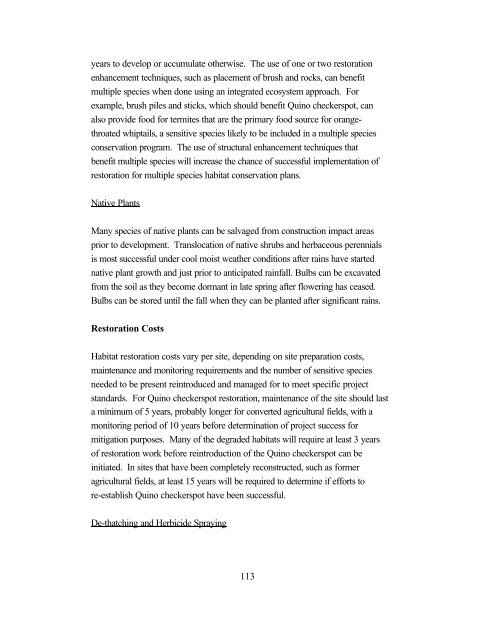Outline of Quino Recovery Plan - The Xerces Society
Outline of Quino Recovery Plan - The Xerces Society
Outline of Quino Recovery Plan - The Xerces Society
Create successful ePaper yourself
Turn your PDF publications into a flip-book with our unique Google optimized e-Paper software.
years to develop or accumulate otherwise. <strong>The</strong> use <strong>of</strong> one or two restoration<br />
enhancement techniques, such as placement <strong>of</strong> brush and rocks, can benefit<br />
multiple species when done using an integrated ecosystem approach. For<br />
example, brush piles and sticks, which should benefit <strong>Quino</strong> checkerspot, can<br />
also provide food for termites that are the primary food source for orangethroated<br />
whiptails, a sensitive species likely to be included in a multiple species<br />
conservation program. <strong>The</strong> use <strong>of</strong> structural enhancement techniques that<br />
benefit multiple species will increase the chance <strong>of</strong> successful implementation <strong>of</strong><br />
restoration for multiple species habitat conservation plans.<br />
Native <strong>Plan</strong>ts<br />
Many species <strong>of</strong> native plants can be salvaged from construction impact areas<br />
prior to development. Translocation <strong>of</strong> native shrubs and herbaceous perennials<br />
is most successful under cool moist weather conditions after rains have started<br />
native plant growth and just prior to anticipated rainfall. Bulbs can be excavated<br />
from the soil as they become dormant in late spring after flowering has ceased.<br />
Bulbs can be stored until the fall when they can be planted after significant rains.<br />
Restoration Costs<br />
Habitat restoration costs vary per site, depending on site preparation costs,<br />
maintenance and monitoring requirements and the number <strong>of</strong> sensitive species<br />
needed to be present reintroduced and managed for to meet specific project<br />
standards. For <strong>Quino</strong> checkerspot restoration, maintenance <strong>of</strong> the site should last<br />
a minimum <strong>of</strong> 5 years, probably longer for converted agricultural fields, with a<br />
monitoring period <strong>of</strong> 10 years before determination <strong>of</strong> project success for<br />
mitigation purposes. Many <strong>of</strong> the degraded habitats will require at least 3 years<br />
<strong>of</strong> restoration work before reintroduction <strong>of</strong> the <strong>Quino</strong> checkerspot can be<br />
initiated. In sites that have been completely reconstructed, such as former<br />
agricultural fields, at least 15 years will be required to determine if efforts to<br />
re-establish <strong>Quino</strong> checkerspot have been successful.<br />
De-thatching and Herbicide Spraying<br />
113
















